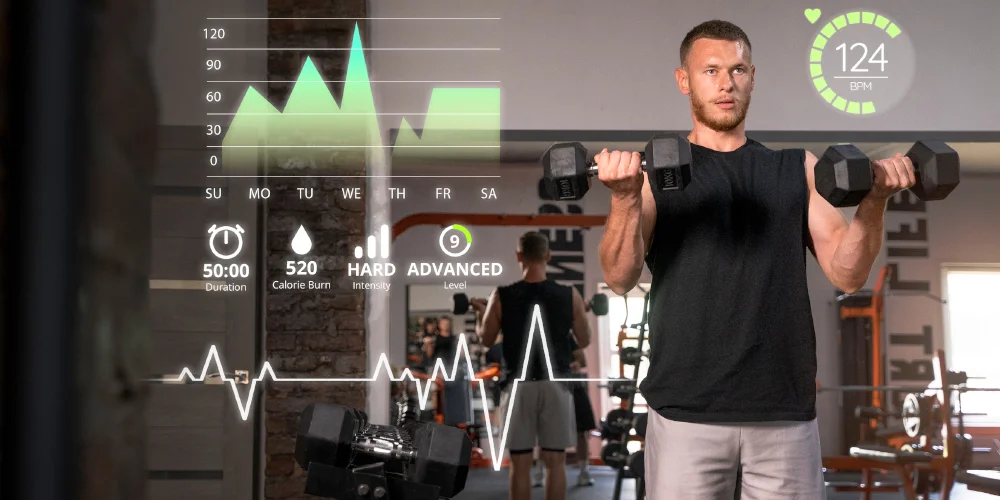Introduction:
In the ever-evolving tapestry of our lives, the pursuit of wellness stands as a cornerstone, and within this pursuit, the significance of fitness takes center stage. It’s not merely about sculpting the physique but about crafting a resilient and vibrant life. Welcome to a narrative woven with health tips, where we explore the profound impact of embracing a fitness-focused lifestyle.
Table of contents
- Introduction:
- Understanding Fitness Focus: Shaping a Lifestyle of Well-Being
- Setting Fitness Goals: Charting Your Path to Wellness
- Tailoring Your Workout Routine: Crafting Fitness Excellence
- Balancing Nutrition and Fitness: Nourishing Your Body for Optimal Performance
- Consistency and Progress Tracking: Navigating the Path to Fitness Success
- Mental Wellbeing and Fitness: Nurturing Harmony Within
- Building a Supportive Community: Thriving Together
- Adapting to Changing Circumstances: Navigating the Ebb and Flow of Fitness
- Conclusion:
The Importance of Fitness in Overall Wellness:
At its core, fitness is not just a physical endeavor; it is a holistic journey that encompasses mental, emotional, and social well-being. The symbiotic relationship between fitness and overall wellness is undeniable. Regular physical activity not only strengthens the body but also nourishes the mind and nurtures emotional balance. It is a potent elixir that enhances the quality of life in multifaceted ways.
Imagine fitness as the compass guiding us through the intricacies of our daily lives. It empowers us to navigate challenges with resilience, propels us towards our goals, and fosters a sense of accomplishment. Whether embarking on a brisk morning walk, engaging in strength training, or embracing the fluidity of yoga, each fitness pursuit contributes to the grand symphony of our well-being.
Introduction to the Concept of a Fitness-Focused Lifestyle:
A fitness-focused lifestyle transcends the conventional view of exercise as a mere routine. It is an ethos that permeates every aspect of our existence, influencing our choices, habits, and the lens through which we perceive our own vitality. It’s about integrating movement seamlessly into our lives, making conscious choices that amplify our well-being, and acknowledging that fitness is not a destination but a continuous journey.
In a world pulsating with information, trends, and ever-evolving methodologies, embracing a fitness-focused lifestyle is akin to choosing a path of perpetual self-improvement. It is a commitment to prioritizing health, recognizing that each step taken in the direction of fitness is an investment in a vibrant and fulfilling life.
The Role of Health Tips in Shaping a Well-Rounded Fitness Journey:
Now, as we embark on this journey, health tips become our compass, guiding us towards optimal well-being. These tips are not mere directives; they are beacons of wisdom illuminating the path to a balanced and sustainable fitness-focused lifestyle. Through insights, recommendations, and practical advice, health tips become invaluable companions, steering us away from pitfalls and propelling us toward success.
In the pages that follow, we’ll delve into the intricacies of what it means to lead a fitness-focused life. From setting personalized fitness goals to tailoring workout routines, balancing nutrition, and fostering mental well-being, each section will unfold layers of understanding and actionable steps. It is an exploration of how health tips, rooted in expertise, science, and real-world wisdom, can shape a narrative of transformative wellness.
As we unravel the secrets, intricacies, and joys of a fitness-focused lifestyle, remember that this is not a rigid prescription but a flexible roadmap. Each health tip is a tool in your hands, and how you wield it will determine the vibrancy and richness of your journey.

Understanding Fitness Focus: Shaping a Lifestyle of Well-Being
Embarking on the journey of a fitness-focused lifestyle requires a nuanced understanding of its essence. This section serves as a compass, guiding us through the foundational aspects that define this way of life.
Defining a Fitness-Focused Lifestyle:
At its core, a fitness-focused lifestyle transcends the traditional confines of exercise routines. It is a conscious and intentional approach to living that places physical well-being at the forefront. It encompasses not only structured workouts but also daily movement, mindful choices, and an awareness of how our lifestyle impacts our overall health.
Imagine fitness not as a task to check off a to-do list but as an integral part of your identity, influencing how you move, eat, and engage with the world. It’s a commitment to weaving physical activity seamlessly into the fabric of your life, recognizing that health is a holistic concept that extends beyond the gym or workout space.
Exploring the Connection Between Fitness and Overall Health:
The interplay between fitness and overall health is a dynamic and symbiotic relationship. Regular physical activity has far-reaching effects that extend beyond muscle toning and cardiovascular health. It positively influences mental clarity, and emotional well-being, and even enhances our immune system.
Consider fitness as the cornerstone of a pyramid, with each facet of well-being—physical, mental, and emotional—resting upon it. As we engage in activities that elevate our heart rate, strengthen our muscles, and enhance our flexibility, we are not merely sculpting our bodies; we are fortifying the foundation of a vibrant and resilient life.
The connection between fitness and overall health is a tapestry of intricate threads, where each thread represents a different facet of our well-being. It’s the boost of endorphins after a workout, the increased energy levels that permeate our daily activities, and the profound sense of accomplishment that comes from pushing our physical limits.
Benefits of Prioritizing Fitness in Daily Life:
Why prioritize fitness in the tapestry of our daily lives? The benefits are profound and far-reaching. Beyond the visible physical changes, a commitment to fitness yields an array of advantages that enhance our quality of life.
- Enhanced Physical Health: Regular physical activity strengthens the cardiovascular system, improves muscle tone, and supports overall physical resilience. It reduces the risk of chronic conditions such as heart disease, diabetes, and obesity.
- Mental Clarity and Focus: Exercise is a powerful ally for our cognitive functions. It improves memory, enhances concentration, and boosts mental clarity. The neurological benefits extend to reducing the risk of cognitive decline as we age.
- Emotional Well-Being: Fitness is a natural mood enhancer. The release of endorphins during exercise contributes to a positive mental state, reducing stress, anxiety, and symptoms of depression. It fosters emotional resilience in the face of life’s challenges.
- Increased Energy Levels: Paradoxically, engaging in physical activity leaves us more energized. Regular exercise improves sleep quality, increases stamina, and reduces feelings of fatigue, contributing to sustained energy levels throughout the day.
- Social Connection: Many fitness pursuits, whether group classes, team sports, or outdoor activities, provide opportunities for social interaction. The sense of community and shared goals enhance our social well-being.
By prioritizing fitness in our daily lives, we not only invest in our immediate well-being but also lay the foundation for a future marked by vitality and longevity. It is an investment that pays dividends in the form of a richer, more fulfilling life.

Setting Fitness Goals: Charting Your Path to Wellness
In the realm of a fitness-focused lifestyle, goals serve as the compass guiding us towards tangible progress and transformative change. This section unveils the profound importance of setting specific and achievable fitness goals, offering insights into crafting objectives that resonate with your unique journey.
The Importance of Setting Specific and Achievable Fitness Goals:
Goals provide a roadmap for our fitness journey, offering direction and purpose to our endeavors. Specificity and achievability are the cornerstones that distinguish effective goals from vague aspirations. When we articulate precisely what we aim to achieve and ensure that our goals are realistic, we set the stage for meaningful progress.
Consider the difference between a vague desire to “get fit” and a specific goal such as “run a 5K in three months.” The latter not only paints a clear picture of the desired outcome but also establishes a timeframe, making the goal measurable and attainable. Specific goals create focus and motivation, turning abstract aspirations into concrete milestones.
Setting achievable goals is equally crucial. While aspirations should inspire us, they must also be grounded in reality. Unrealistic goals can lead to frustration and demotivation. A series of smaller, achievable goals that build upon one another creates a staircase of success, each step propelling us towards a more significant transformation.
Tips for Creating Personalized Fitness Objectives:
The beauty of fitness goals lies in their personalization. Your fitness journey is uniquely yours, and your goals should reflect your aspirations, preferences, and current fitness level. Consider the following tips when crafting personalized fitness objectives:
- Reflect on Your Why: Define the underlying reasons driving your fitness journey. Whether it’s improving health, boosting energy levels, or achieving a specific milestone, understanding your “why” provides a meaningful foundation for goal-setting.
- Be Specific and Measurable: Clearly articulate what you want to achieve and establish criteria for measuring progress. Instead of a vague goal like “exercise more,” opt for specificity, such as “complete a 30-minute workout five times a week.”
- Break It Down: Divide larger goals into smaller, manageable milestones. This not only makes the journey less overwhelming but also allows for a sense of accomplishment at each stage.
- Consider Different Dimensions: Fitness goals can encompass various dimensions, including cardiovascular health, strength, flexibility, and endurance. Ensure your objectives cover a well-rounded spectrum of fitness components.
- Align with Your Preferences: Tailor your goals to activities you enjoy. If you love outdoor activities, consider goals related to hiking, biking, or running. Enjoy the camaraderie of group activities? Explore fitness classes or team sports.
- Set a Timeline: Establish a realistic timeframe for achieving your goals. Having a deadline creates a sense of urgency and commitment, fostering consistency in your fitness routine.
How Goal setting Contributes to a Structured Fitness Routine:
Goals not only shape our aspirations but also play a pivotal role in creating a structured and purposeful fitness routine. Here’s how goal-setting contributes to the framework of a well-rounded fitness regimen:
- Direction and Focus: Goals provide a clear sense of direction, guiding your choices in terms of exercise selection, intensity, and frequency. They act as a focal point, ensuring that each workout contributes to your overarching objectives.
- Motivation and Accountability: Knowing that each workout brings you closer to your goals serves as a powerful motivator. Goals create a sense of accountability, encouraging you to stay committed even on days when motivation wanes.
- Progress Tracking: Goals enable you to track progress systematically. Whether it’s increasing the intensity of your workouts, achieving specific fitness milestones, or noting improvements in endurance, progress tracking reinforces your commitment and fuels motivation.
- Adaptation and Evolution: As you achieve your goals, your fitness routine evolves. New aspirations replace accomplished ones, ensuring that your routine remains dynamic and aligned with your ever-changing objectives.

Tailoring Your Workout Routine: Crafting Fitness Excellence
As we navigate the intricate landscape of a fitness-focused lifestyle, the spotlight turns to the art of tailoring workout routines. This section illuminates the profound significance of personalized plans, the synergy of cardiovascular, strength, and flexibility exercises, and the art of adaptation to individual preferences and fitness levels.
The Significance of Personalized Workout Plans:
A one-size-fits-all approach has no place in the realm of fitness. Personalization is the linchpin that transforms a routine into a journey uniquely crafted for you. It’s about understanding your body, preferences, and goals to curate a workout plan that resonates with your individuality.
Consider this personalized approach as a roadmap sculpted to navigate your fitness landscape. A plan crafted with intentionality ensures that each exercise serves a purpose, aligning with your objectives and contributing to the overall symphony of your well-being. It’s a mindful investment in yourself, acknowledging that your fitness journey is as distinctive as your fingerprint.
Incorporating a Mix of Cardiovascular, Strength, and Flexibility Exercises:
A well-rounded fitness routine mirrors the diversity of our well-being. Cardiovascular, strength, and flexibility exercises form the triad that creates harmony in your workout regimen.
- Cardiovascular Exercises: These activities elevate your heart rate, enhancing cardiovascular health, and promoting calorie burn. Whether it’s brisk walking, running, cycling, or dancing, cardiovascular exercises form the rhythmic foundation of your routine, fostering endurance and stamina.
- Strength Training: Building muscle strength is integral to overall fitness. Incorporating resistance training, bodyweight exercises, or weightlifting not only sculpts lean muscle but also contributes to improved metabolism, bone density, and functional fitness.
- Flexibility Exercises: Often overlooked, flexibility is the unsung hero of a well-rounded routine. Stretching exercises, yoga, or Pilates enhance flexibility, reduce the risk of injuries, and promote joint health. They also contribute to a sense of ease and fluidity in your movements.
The synergy of these elements creates a dynamic equilibrium in your workout routine, ensuring that no facet of your fitness is neglected. Just as a composer blends different instruments to create a symphony, your workout routine harmonizes these exercises to produce a holistic and transformative effect.
Adapting Workouts to Individual Preferences and Fitness Levels:
One of the most potent motivators for sustained fitness engagement is alignment with your preferences. Tailoring your workouts to activities you enjoy not only makes the journey more enjoyable but also increases adherence to your routine.
- Explore Diverse Activities: If traditional gym workouts don’t resonate with you, explore alternative activities. Hiking, swimming, dancing, or participating in group classes can infuse joy and variety into your routine.
- Consider Fitness Levels: Your current fitness level serves as the starting point for your journey. Gradual progression ensures sustainable results without risking injury. Adapt exercises, intensity, and duration based on your current capabilities, allowing your fitness journey to evolve organically.
- Create Variety: Monotony is the nemesis of long-term adherence. Infuse variety into your routine by periodically introducing new exercises, trying different workout formats, or exploring outdoor activities. Variety not only prevents boredom but also challenges your body in new ways.
Remember, your workout routine is not a rigid template but a living, breathing expression of your commitment to well-being. It should evolve, adapt, and align with the ebb and flow of your life.

Balancing Nutrition and Fitness: Nourishing Your Body for Optimal Performance
In the intricate dance of a fitness-focused lifestyle, the partnership between nutrition and exercise takes center stage. This section delves into the pivotal role of nutrition in supporting fitness goals, offers tips for crafting a balanced diet that fuels workouts, and emphasizes the indispensable nature of hydration in this dynamic interplay.
The Role of Nutrition in Supporting Fitness Goals:
Fueling your body is not just about satisfying hunger; it’s about providing the essential elements that empower your fitness journey. Nutrition is the silent architect behind your physical endeavors, influencing your energy levels, recovery, and overall performance.
- Energy Source: Carbohydrates are the primary source of energy for physical activities. Incorporating complex carbohydrates such as whole grains, fruits, and vegetables ensures a sustained and reliable energy supply for your workouts.
- Muscle Repair and Growth: Protein plays a crucial role in repairing and building muscles. Adequate protein intake supports recovery, enhances muscle strength, and contributes to overall fitness. Include sources like lean meats, legumes, dairy, and plant-based proteins in your diet.
- Vitamins and Minerals: Essential vitamins and minerals are the unsung heroes of your fitness journey. They contribute to various physiological processes, including energy metabolism and muscle function. A diverse and colorful array of fruits and vegetables provides a spectrum of these micronutrients.
- Hydration Support: Staying well-hydrated is integral to optimal performance. Water is the elixir that regulates body temperature, facilitates nutrient transport, and supports overall bodily functions. Adequate hydration prevents fatigue, cramping, and enhances endurance during workouts.
Tips for Creating a Balanced Diet to Fuel Workouts:
Crafting a diet that synergizes with your fitness goals involves intentional choices and a mindful approach to nourishment. Consider the following tips for creating a balanced diet that serves as the cornerstone of your fitness-focused lifestyle:
- Macro and Micro Nutrient Balance: Ensure a balance of macronutrients (carbohydrates, proteins, and fats) to meet your energy needs. Additionally, focus on incorporating a variety of micronutrients through diverse food choices.
- Timing Matters: Consider the timing of your meals in relation to your workouts. Pre-workout meals should provide sustained energy, while post-workout meals support recovery and muscle repair. Snacks rich in protein and carbohydrates can bridge the gap between meals.
- Whole Foods Emphasis: Prioritize whole, minimally processed foods. These include fruits, vegetables, lean proteins, whole grains, and healthy fats. Whole foods provide a spectrum of nutrients without the additives often found in processed alternatives.
- Mindful Eating: Pay attention to your body’s hunger and satiety cues. Mindful eating involves savoring each bite, recognizing true hunger, and respecting your body’s signals for fullness. This approach fosters a healthy relationship with food.
- Adapt to Individual Needs: Each person’s nutritional requirements are unique. Consider consulting with a registered dietitian or nutritionist to create a personalized nutrition plan that aligns with your fitness goals, preferences, and any specific dietary considerations.
Hydration as a Crucial Aspect of a Fitness-Focused Lifestyle:
In the intricate web of nutrition and fitness, hydration emerges as a non-negotiable element. Water is the lifeblood that sustains your body’s functions and optimizes your physical performance.
- Prevent Dehydration: Dehydration can hinder performance, lead to fatigue, and impede recovery. Consume an adequate amount of water throughout the day, and pay attention to increased fluid needs during workouts.
- Electrolyte Balance: Intense workouts can result in electrolyte loss through sweat. Replenish electrolytes with beverages containing sodium, potassium, and magnesium, especially after prolonged or vigorous exercise.
- Individual Hydration Needs: Hydration needs vary based on factors such as climate, intensity of exercise, and individual differences. Listen to your body, and adjust your fluid intake accordingly.
- Beyond Water: While water is the primary hydrating beverage, herbal teas, infused water, and electrolyte-rich drinks can add variety to your hydration routine.

Consistency and Progress Tracking: Navigating the Path to Fitness Success
In the symphony of a fitness-focused lifestyle, consistency serves as the conductor orchestrating your journey, while progress tracking becomes the melody that resonates with achievement. This section delves into the pivotal role of consistency in fitness endeavors, offers methods for tracking progress, and provides insights into overcoming challenges while staying motivated on this transformative journey.
Emphasizing the Importance of Consistency in Fitness Endeavors:
Consistency is the bedrock upon which fitness success is built. It is the commitment to showing up, putting in the effort, and making choices that align with your well-being on a regular basis. Here’s why consistency is the linchpin of a thriving fitness journey:
- Cumulative Impact: Fitness is not a one-time event; it’s the sum total of small, consistent efforts over time. Each workout, healthy meal, and mindful choice contributes to the cumulative impact that shapes your well-being.
- Habit Formation: Consistent actions form habits. By integrating fitness into your routine consistently, you transform it from a conscious effort into a natural part of your lifestyle. Habits, once established, require less conscious effort and become integral to your daily life.
- Adaptation and Progress: The body adapts to consistent stimuli. Regular exercise, when maintained, leads to physiological adaptations that contribute to improved strength, endurance, and overall fitness. Consistency is the catalyst for progress.
- Mental Resilience: The discipline of consistency extends beyond the physical realm. It cultivates mental resilience, teaching you to navigate challenges, overcome setbacks, and stay committed even when motivation wanes.
Ways to Track Progress and Celebrate Achievements:
Tracking progress transforms abstract fitness goals into tangible, measurable achievements. It provides motivation, illuminates the path forward, and offers a source of celebration. Here are effective methods for tracking progress:
- Keep a Fitness Journal: Record your workouts, noting exercises, sets, and repetitions. This not only provides a historical record of your progress but also helps in identifying patterns and areas for improvement.
- Use Fitness Apps: Numerous apps are designed to track workouts, nutrition, and overall fitness progress. They often provide charts, statistics, and reminders, making progress tracking seamless and interactive.
- Take Regular Measurements: Beyond scale weight, consider measurements like body fat percentage, waist circumference, or photos to visually track changes. These methods offer a comprehensive view of your physical transformation.
- Set Benchmark Assessments: Establish regular benchmark assessments to evaluate your fitness level. This could include timed runs, strength tests, or flexibility assessments. Comparing results over time showcases improvements.
- Celebrate Milestones: Acknowledge and celebrate both small and significant milestones. Whether it’s lifting a heavier weight, achieving a personal best in a run, or consistently following a workout routine for a month, each accomplishment deserves recognition.
Overcoming Challenges and Staying Motivated on the Fitness Journey:
Challenges are an inevitable part of any journey, and the fitness odyssey is no exception. Here are insights into overcoming challenges and staying motivated:
- Anticipate Plateaus: Recognize that progress may not always be linear. Plateaus are a natural part of the journey. During these times, focus on refining your routine, exploring new activities, or adjusting your goals.
- Diversify Your Routine: Monotony can lead to boredom and diminished motivation. Periodically introduce new exercises, try different fitness classes, or explore outdoor activities to keep your routine fresh and engaging.
- Build a Support System: Share your fitness goals with friends, family, or workout buddies. A supportive community can provide encouragement, share insights, and serve as a source of motivation during challenging times.
- Mind-Body Connection: Cultivate mindfulness in your fitness routine. Pay attention to how your body feels during and after workouts. Embrace the mental benefits of exercise, such as stress reduction and improved mood.
- Set Realistic Expectations: While ambitious goals are commendable, setting unrealistic expectations can lead to frustration. Embrace the journey, celebrating both the successes and the lessons learned along the way.

Mental Wellbeing and Fitness: Nurturing Harmony Within
In the intricate dance of a fitness-focused lifestyle, the synergy between physical exertion and mental resilience emerges as a transformative force. This section delves into the profound connection between mental health and fitness, offers techniques for managing stress through purposeful activities, and unravels the holistic impact of a fitness-focused lifestyle on mental well-being.
Exploring the Connection Between Mental Health and Fitness:
The intimate dance between mental health and fitness is one of reciprocity. As physical activity engages the body, it concurrently nourishes the mind. Here, we delve into the intricacies of this symbiotic relationship:
- Endorphin Release: Exercise is a natural stimulant for the release of endorphins, often referred to as the body’s “feel-good” chemicals. These neurotransmitters contribute to a positive mood, reduce perceptions of pain, and create a sense of well-being.
- Stress Reduction: Physical activity serves as a powerful outlet for stress. Engaging in exercise helps regulate the body’s stress response, reducing levels of cortisol and promoting a sense of calm. It provides a constructive way to channel and manage stressors.
- Improved Sleep: Regular physical activity is linked to improved sleep quality. Quality sleep is integral to mental health, influencing cognitive function, emotional resilience, and overall well-being.
- Cognitive Benefits: Exercise is associated with cognitive benefits, including improved memory, enhanced concentration, and a reduced risk of cognitive decline as we age. The neurological impact of fitness extends beyond the physical realm.
Techniques for Managing Stress Through Fitness Activities:
Fitness activities serve as a canvas on which we paint our stress-relief strategies. Here are techniques for infusing your fitness routine with purposeful stress management:
- Mindful Movement: Incorporate mindful movement practices such as yoga or tai chi into your routine. These activities emphasize the connection between movement and breath, fostering a sense of presence and tranquility.
- Nature Walks or Runs: Take your fitness outdoors and immerse yourself in nature. Whether it’s a leisurely walk or an invigorating run, the combination of physical activity and natural surroundings has a rejuvenating effect on the mind.
- High-Intensity Interval Training (HIIT): Short bursts of intense exercise followed by periods of rest characterize HIIT. This approach not only contributes to physical fitness but also serves as an efficient stress-buster.
- Dance as Expression: Dance is a form of physical expression that combines movement with music. It provides an avenue for creativity, emotional expression, and a joyful release of energy.
- Meditative Exercise: Engage in exercises that promote a meditative state, such as swimming, cycling, or rowing. These activities encourage a rhythmic focus that can be meditative and soothing.
The Holistic Impact of a Fitness-Focused Lifestyle on Mental Wellbeing:
A fitness-focused lifestyle transcends the physical, casting its transformative glow on mental wellbeing in profound ways. Here’s how:
- Emotional Resilience: Regular exercise enhances emotional resilience, helping individuals cope with life’s challenges and bounce back from setbacks. It provides a constructive outlet for emotions, reducing the impact of stressors.
- Positive Body Image: Engaging in fitness activities fosters a positive relationship with one’s body. It shifts the focus from external appearance to the capabilities and strength of the body, promoting body acceptance and appreciation.
- Sense of Achievement: Achieving fitness goals, whether big or small, contributes to a sense of accomplishment. This positive reinforcement enhances self-esteem and reinforces the belief in one’s ability to set and achieve meaningful objectives.
- Community Connection: Participating in group fitness classes or sports fosters a sense of community. Social connections contribute to mental wellbeing, providing support, encouragement, and a sense of belonging.
- Stress Resilience: A consistent fitness routine builds resilience against the detrimental effects of chronic stress. It equips individuals with coping mechanisms, reducing the likelihood of stress-related mental health issues.

Building a Supportive Community: Thriving Together
In the mosaic of a fitness-focused lifestyle, the presence of a supportive community becomes a cornerstone, enriching the journey with shared experiences, encouragement, and a collective spirit. This section explores the pivotal role of social support in maintaining a fitness-focused lifestyle, offers tips for cultivating a community of like-minded individuals, and emphasizes the transformative power of sharing successes and challenges within this supportive network.
The Role of Social Support in Maintaining a Fitness-Focused Lifestyle:
Embarking on a fitness journey is not a solitary endeavor; it’s a collective voyage woven into the fabric of a supportive community. Here’s why social support is an indispensable ally in maintaining a fitness-focused lifestyle:
- Motivation and Accountability: A supportive community provides motivation and accountability. Knowing that others share similar goals creates a collective momentum that propels each individual forward. The sense of accountability encourages consistent engagement in fitness activities.
- Shared Experiences: Challenges and triumphs are inherent in any fitness journey. In a community, these experiences are shared, fostering a sense of camaraderie. Whether overcoming obstacles or celebrating achievements, the shared narrative creates bonds and mutual understanding.
- Diverse Perspectives: A community brings together individuals with diverse backgrounds, experiences, and approaches to fitness. This diversity enriches the collective knowledge pool, offering a range of perspectives, insights, and ideas that contribute to individual growth.
- Emotional Support: Fitness is intertwined with mental and emotional well-being. During challenging times, a supportive community provides a safety net of emotional support. Encouragement, empathy, and understanding create a nurturing environment that transcends the physical aspects of fitness.
Tips for Building a Community of Like-Minded Individuals:
Building a community is a deliberate and intentional process. Here are tips for cultivating a community of like-minded individuals who share a passion for a fitness-focused lifestyle:
- Join Fitness Classes or Groups: Participate in fitness classes, group workouts, or sports leagues. These settings naturally foster a sense of community among individuals pursuing similar fitness goals.
- Online Fitness Communities: Explore online platforms dedicated to fitness, where individuals from diverse locations connect. Social media groups, forums, and fitness apps provide virtual spaces to share experiences, seek advice, and celebrate milestones.
- Local Fitness Events: Attend local fitness events, charity runs, or wellness workshops. These gatherings bring together individuals with a shared interest in health and fitness, providing opportunities to form connections.
- Create Fitness Challenges: Organize or participate in fitness challenges within your existing social circles. Challenges create a shared goal, sparking collective motivation and fostering a sense of camaraderie.
- Engage in Group Activities: Whether it’s hiking, cycling, or team sports, engaging in group activities promotes a sense of community. Shared physical activities create bonds that extend beyond the workout setting.
Sharing Successes and Challenges Within a Supportive Network:
Communication within a community is the thread that weaves individual stories into a tapestry of shared experiences. Here’s the transformative power of sharing successes and challenges within a supportive network:
- Celebrating Achievements: Share your fitness milestones, whether it’s reaching a personal best, completing a challenging workout, or achieving a specific goal. Celebrating achievements amplifies the joy and reinforces the sense of collective success.
- Seeking Advice and Insights: When faced with challenges or uncertainties, leverage the collective wisdom of the community. Seeking advice, sharing concerns, and discussing challenges open avenues for support and solutions.
- Creating a Positive Feedback Loop: Positive reinforcement within the community creates a feedback loop of encouragement. Offering words of support, acknowledging efforts, and celebrating progress contribute to a positive and uplifting environment.
- Learning from Others: Each individual within the community brings a unique perspective and approach to fitness. Learning from others’ experiences, strategies, and insights expands your knowledge base and enriches your own fitness journey.
- Fostering a Culture of Inclusivity: A supportive community embraces inclusivity and fosters an environment where everyone feels valued and welcomed. This culture strengthens the bonds within the community and encourages sustained engagement.

Adapting to Changing Circumstances: Navigating the Ebb and Flow of Fitness
In the dynamic tapestry of life, adapting to changing circumstances is a skill that anchors a sustainable fitness-focused lifestyle. This section unveils strategies for navigating busy times or unforeseen events, emphasizes the importance of flexibility in maintaining a long-term fitness focus, and provides insights on how to bounce back from setbacks, staying resolute on your transformative journey.
Strategies for Adapting Fitness Routines During Busy Times or Unforeseen Circumstances:
Life is a kaleidoscope of events, and sometimes, the pace quickens or unexpected challenges arise. Adapting your fitness routine to the ebb and flow of circumstances is crucial. Here are strategies to ensure your commitment to fitness remains resilient:
- Short, Intense Workouts: During busy periods, opt for shorter yet intense workouts. High-Intensity Interval Training (HIIT) or quick, focused exercises allow you to maintain fitness levels in a condensed timeframe.
- Prioritize Consistency Over Duration: On hectic days, prioritize consistency over lengthy workouts. Even a brief session contributes to your routine, sustaining the habit during demanding times.
- Incorporate Micro Workouts: Break down your workout into micro sessions throughout the day. Short walks, stair climbing, or brief bodyweight exercises collectively contribute to your daily activity level.
- Explore Time-Efficient Activities: Choose activities that offer maximum benefits in minimal time. Activities like kettlebell workouts, circuit training, or compound exercises optimize efficiency.
- Schedule Workouts as Non-Negotiable Appointments: Treat your workouts as non-negotiable appointments. Schedule them in advance, and honor these appointments with the same dedication you would a professional commitment.
The Importance of Flexibility in Maintaining a Long-Term Fitness Focus:
Flexibility extends beyond physical stretches; it’s a mindset that fortifies your fitness journey. Here’s why flexibility is an indispensable ally in maintaining a long-term focus:
- Adaptability to Life Changes: Life is inherently unpredictable. Flexibility in your fitness approach allows you to adapt to life changes, ensuring that your commitment to well-being remains steadfast amidst shifting circumstances.
- Prevention of Burnout: A rigid, unyielding approach to fitness can lead to burnout. Flexibility allows for variety, adaptability, and the occasional reprieve, preventing monotony and sustaining your enthusiasm for the long haul.
- Incorporation of Enjoyable Activities: Flexibility enables you to incorporate activities you genuinely enjoy. Whether it’s dancing, hiking, or trying new fitness classes, aligning your routine with your interests enhances enjoyment and long-term adherence.
- Mindful Adjustments: Flexibility includes the ability to make mindful adjustments to your goals. If circumstances necessitate a shift in priorities, adjusting your fitness goals with a compassionate mindset ensures continued progress.
- Balancing Intensity and Recovery: Flexibility involves balancing intense workouts with periods of active recovery. This ebb and flow optimize performance, reduce the risk of burnout or injury, and contribute to sustained engagement.
How to Bounce Back from Setbacks and Stay Committed:
Setbacks are not detours; they are part of the journey. Bouncing back from setbacks requires resilience and a commitment to your long-term well-being. Here’s how to navigate setbacks and stay committed:
- Embrace a Growth Mindset: View setbacks as opportunities for growth rather than failures. A growth mindset fosters resilience, encourages learning from challenges, and propels you forward with newfound wisdom.
- Reflect and Learn: When faced with setbacks, take time to reflect. Identify contributing factors, assess what can be learned from the experience, and use this insight to make informed adjustments to your approach.
- Set Realistic Expectations: Setbacks may occur when expectations are unrealistic. Ensure your goals are achievable and aligned with your current circumstances. Celebrate progress, no matter how incremental.
- Seek Support: Share your challenges with your fitness community or seek support from friends and family. External perspectives and encouragement can provide valuable insights and motivation during challenging times.
- Reignite Motivation: Rediscover the intrinsic motivations that fuel your fitness journey. Whether it’s the joy of movement, the sense of accomplishment, or the pursuit of overall well-being, reconnect with the elements that ignited your commitment.
Conclusion:
In the mosaic of well-being, the chapters we’ve explored converge into a vibrant tapestry that outlines the contours of a thriving fitness-focused lifestyle. Let’s weave together the key points, extend words of encouragement, and reflect on the transformative impact of embracing a holistic approach to wellness.
Summarizing the Key Points:
Our journey has unfolded through the lens of a fitness-focused lifestyle, revealing key insights that serve as guiding principles:
- Understanding Fitness Focus: It begins with a clear understanding of what it means to prioritize fitness, transcending mere physical activity to embrace a comprehensive approach that nurtures body and mind.
- Setting Personalized Goals: Tailoring your fitness goals to align with your individual aspirations and capabilities forms the foundation of a sustainable and rewarding journey.
- Crafting Diverse Workout Routines: The synergy of cardiovascular, strength, and flexibility exercises creates a harmonious and effective workout routine that caters to the multifaceted nature of well-being.
- Balancing Nutrition and Fitness: The intricate dance between nutrition and fitness underscores the importance of a balanced diet, emphasizing the role of macronutrients, micronutrients, and hydration in optimizing performance.
- Consistency and Progress Tracking: Consistency is the linchpin of success, and tracking progress transforms abstract goals into tangible achievements, providing motivation and a roadmap for continued growth.
- Mental Wellbeing and Fitness: The intimate connection between physical activity and mental health serves as a catalyst for emotional resilience, stress management, and overall cognitive well-being.
- Building a Supportive Community: Surrounding yourself with like-minded individuals fosters motivation, shared experiences, and a sense of belonging that propels your fitness journey forward.
- Adapting to Changing Circumstances: Flexibility is the cornerstone of long-term success, offering strategies to navigate life’s twists and turns, maintain resilience, and sustain a commitment to well-being.
Encouragement for Readers:
To every reader embarking on or continuing their fitness journey, we extend words of encouragement. Embrace the principles discussed, recognizing that each step, no matter how small, contributes to the transformative evolution of your well-being. Your journey is unique, and your commitment to health is a commendable investment in the richness of your life.
Closing Thoughts on Transformative Impact:
As we stand at the intersection of fitness and holistic wellness, it’s essential to reflect on the transformative impact of adopting a fitness-focused approach. Beyond physical transformations, this journey radiates into every facet of your existence:
- Empowerment: A fitness-focused lifestyle empowers you with a profound understanding of your body, cultivating a sense of agency and self-efficacy that transcends the gym or workout space.
- Resilience: The resilience cultivated through consistent effort, adaptability, and support positions you to navigate life’s challenges with fortitude, both physically and mentally.
- Joyful Vitality: The joy of movement, the satisfaction of achieving goals, and the camaraderie within a community infuse your life with a sense of vitality that ripples into your daily experiences.
- Balanced Well-Being: The harmony between physical fitness, mental well-being, and supportive connections creates a balanced tapestry of wellness. It’s not just about the pursuit of fitness; it’s about living a life that flourishes in its entirety.
In closing, let the principles unveiled in this exploration serve as beacons guiding you toward a life where wellness is not a destination but a dynamic, transformative journey. May your commitment to a fitness-focused lifestyle illuminate your path, enrich your experiences, and become a lifelong companion on the extraordinary odyssey of well-being. The canvas is yours to shape, and the journey continues with each intentional step toward a thriving, holistic existence.
Make sure to watch my YouTube videos for healthy food recipes

